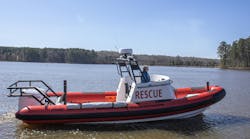Subject: Vehicle Lock-Ins
Topic: Protocols for Vehicle Lock-In Incidents
Objective: Review the life-threatening hazards associated with a child locked inside a vehicle and train on department procedures for accessing a simulated patient in this situation.
Task: Given an acquired vehicle for training purposes with all windows rolled up and all doors closed and locked, a two-person team shall demonstrate procedures for accessing a simulated patient locked inside.
In the September 2002 installment of the University of Extrication series, the issue of vehicle lock-ins was addressed. A major focus of that column involved determining which glass to break to access a child locked inside the vehicle. Breaking out a window remains the “bottom line†in vehicle forcible-entry situations. It is quick and provides immediate results, so vitally necessary in dire emergency situations. In the years that have passed since that original column was published, the dangers of children locked inside vehicles remain real and deadly.
Kids in Cars, www.kidsincars.org, is a Missouri-based, national, non-profit organization dedicated to preventing injuries and deaths of children being left unattended in or around motor vehicles. According to Kids in Cars, more than 720 children have died in the United States since 1999 because they were left unattended in or around cars. Some were due to the vehicle being in motion and others were due to children being trapped in trunks. About a quarter of these deaths (24%) were because children were left alone in cars during hot weather. In 2003, Texas led the nation in the number of heat-related car deaths. Authorities report that 75% of the dangerous temperature rise inside a vehicle occurs within the first five minutes of closing the door.
What has changed, however, since that 2002 column is the introduction of an alternative vehicle entry tool popular among tow truck operators and locksmith agencies. This new alternative technique is important for responders to consider, especially when confronted with a situation where the child’s life is not immediately endangered. An example would be a child locked inside a vehicle that is parked in the shade with the air conditioner running. The child, as viewed through the window glass, may appear to be fully alert and physically unaffected by the situation when responders arrive on scene. Responders now have an alternative to glass breaking or less-effective door-unlocking procedures.
Since 2005, the McKinney, TX, Fire Department has outfitted all fire apparatus, ambulances and the duty chief’s vehicle with a new vehicle-entry tool kit known commercially as The Big Easy. Sold through various automotive and tow-truck supply outlets, it is a product of Steck Manufacturing, a Dayton, OH-based firm (www.steckmfg.com). Prior to the introduction of this unique tool kit, McKinney responders, like many across the country, either broke out a window glass or fumbled with door unlocking tools inserted inside the door panel in an attempt to release the door lock mechanism. We resorted to coat hangers, wires, flat pieces of metal…anything that could possibly get the door open. Department protocols still encourage responders to break out a window if, in their opinion, the situation is “IDLHâ€: life-threatening to the child locked inside the vehicle. The Big Easy, however, has become the tool of choice for McKinney responders.
With the Big Easy system, responders use a long metal rod with a T-handle at one end and a pointed tip at the other to unlock the vehicle from the inside. Accompanying this rod is a plastic wedge and an inflatable wedge. With this vehicle-entry system, McKinney responders have enjoyed tremendous success in a wide variety of vehicle lock-in situations, an almost daily emergency call for these Texas responders during warm weather.
The Big Easy kit enables responders to actuate the door handle, manual lock button or electric lock button on more than 98% of all cars and trucks by operating the tool a inside the vehicle, not inside the door. There is a big difference. Responders begin their work by forcing the rigid wedge into the door-frame edge, maneuvering it so the top of the door frame starts to move away from the roofline of the vehicle. As the wedge is pushed deeper, it creates an opening that eventually allows the inflatable wedge to be slipped inside the door frame. Once in place, the bladder of the inflatable wedge is pumped up and the door frame opens even further.
Once there is enough of an opening between the door frame and the roofline, the long 56-inch tool can be maneuvered inside the vehicle. With a spotter on the opposite side acting as the “eyesâ€â€™ of the tool operator, the rescuer controlling the Big Easy maneuvers the tip of the rod in an effort to either pull on the door handle, operate a power door lock or press on a power window button. We’ve even used the tip to retrieve the keys lying on the front seat. We like this tactical approach to vehicle unlocking because it presents no danger of door airbag activation or potentially disconnecting internal door linkages.
TASK: Given an acquired vehicle for training purposes with all windows rolled up and all doors closed and locked, a two-person team shall demonstrate department-approved procedures for accessing a simulated patient locked inside.
Ron Moore, a Firehouse® contributing editor, is a battalion chief and the training officer for the McKinney, TX, Fire Department. He also authors a monthly online article in the Firehouse.com “MembersZone†and serves as the Forum Moderator for the extrication section of the Firehouse.com website. Moore can be contacted directly at [email protected].






